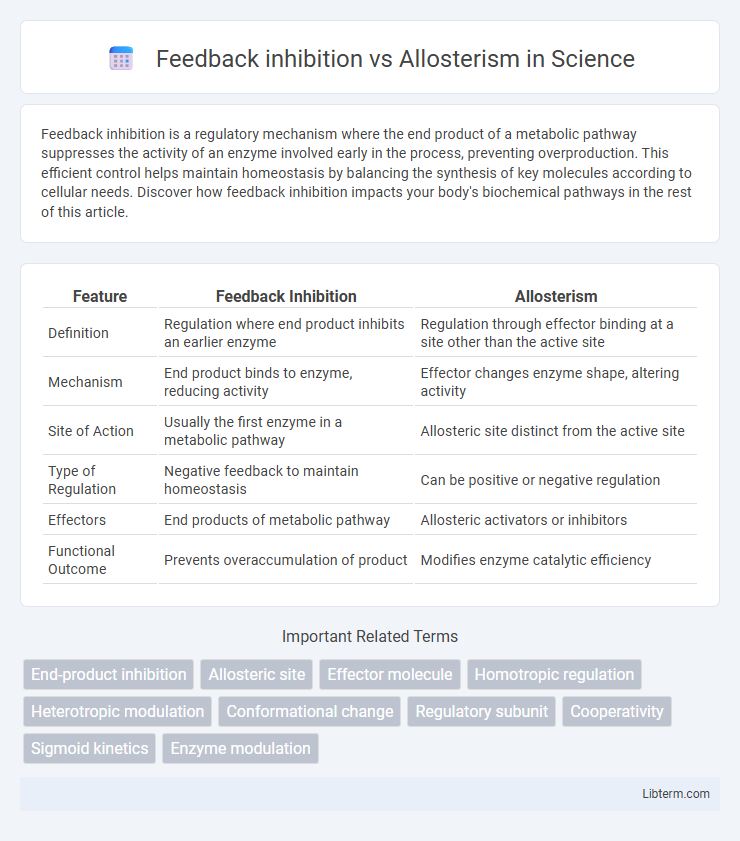Feedback inhibition is a regulatory mechanism where the end product of a metabolic pathway suppresses the activity of an enzyme involved early in the process, preventing overproduction. This efficient control helps maintain homeostasis by balancing the synthesis of key molecules according to cellular needs. Discover how feedback inhibition impacts your body's biochemical pathways in the rest of this article.
Table of Comparison
| Feature | Feedback Inhibition | Allosterism |
|---|---|---|
| Definition | Regulation where end product inhibits an earlier enzyme | Regulation through effector binding at a site other than the active site |
| Mechanism | End product binds to enzyme, reducing activity | Effector changes enzyme shape, altering activity |
| Site of Action | Usually the first enzyme in a metabolic pathway | Allosteric site distinct from the active site |
| Type of Regulation | Negative feedback to maintain homeostasis | Can be positive or negative regulation |
| Effectors | End products of metabolic pathway | Allosteric activators or inhibitors |
| Functional Outcome | Prevents overaccumulation of product | Modifies enzyme catalytic efficiency |
Introduction to Feedback Inhibition and Allosterism
Feedback inhibition regulates metabolic pathways by using the end product to inhibit an upstream enzyme, preventing overproduction. Allosterism involves the binding of effectors at specific regulatory sites distinct from the active site, modulating enzyme activity through conformational changes. Both mechanisms are crucial for cellular homeostasis and efficient metabolic control.
Definitions: Feedback Inhibition vs. Allosteric Regulation
Feedback inhibition is a regulatory mechanism where the end product of a metabolic pathway binds to an enzyme involved earlier in the pathway, reducing its activity and preventing overproduction. Allosteric regulation involves the binding of effector molecules to specific sites on an enzyme other than the active site, causing conformational changes that enhance or inhibit enzyme activity. Both mechanisms control metabolic pathways, but feedback inhibition specifically uses the final product as an inhibitor, while allosteric regulation includes diverse effectors that modulate enzyme function at distinct allosteric sites.
Mechanisms of Feedback Inhibition
Feedback inhibition involves the end product of a metabolic pathway binding to an enzyme early in the pathway, typically the first committed enzyme, to reduce its activity and prevent overproduction. This regulation occurs through direct interaction at the active site or through an allosteric site, causing conformational changes that decrease enzyme affinity for substrates. The mechanism ensures metabolic balance by dynamically adjusting enzyme activity based on product concentration, conserving cellular resources.
Mechanisms of Allosteric Regulation
Allosteric regulation involves the binding of effectors to specific sites on an enzyme, inducing conformational changes that modulate enzymatic activity either by enhancing or inhibiting substrate binding. Feedback inhibition specifically refers to the end product of a metabolic pathway acting as an allosteric inhibitor to regulate enzyme function, thus controlling the pathway's output. This mechanism ensures metabolic balance by dynamically adjusting enzyme activity through reversible, non-covalent interactions at distinct allosteric sites.
Key Differences between Feedback Inhibition and Allosterism
Feedback inhibition involves the end product of a metabolic pathway binding to the first enzyme to reduce its activity, thereby regulating its own synthesis. Allosterism refers to the regulation of an enzyme's function through the binding of an effector molecule at a specific site other than the active site, causing conformational changes that alter enzyme activity. The key difference lies in feedback inhibition targeting the initial enzyme as a metabolic control mechanism, whereas allosterism encompasses a broader range of enzyme regulation through structural modifications induced by effector binding.
Biological Examples of Feedback Inhibition
Feedback inhibition regulates metabolic pathways by end products binding to enzymes, exemplified by the inhibition of threonine deaminase in isoleucine biosynthesis, preventing excess isoleucine production. This mechanism contrasts with allosterism, where enzyme activity is modulated by effectors binding at distinct allosteric sites, often without the end product being the inhibitor. In bacterial amino acid synthesis, enzymes like glutamine synthetase and aspartate kinase exhibit feedback inhibition to maintain cellular homeostasis and resource efficiency.
Biological Examples of Allosterism
Feedback inhibition regulates metabolic pathways by end-products binding to the initial enzyme, whereas allosterism involves effector molecules binding to enzyme sites other than the active site, altering enzyme activity. Hemoglobin exemplifies biological allosterism by exhibiting oxygen binding Cooperativity, where oxygen binding at one site increases affinity at others. Aspartate transcarbamoylase (ATCase) demonstrates allosteric regulation with CTP acting as an inhibitor and ATP as an activator, modulating pyrimidine biosynthesis.
Functional Roles in Metabolic Pathways
Feedback inhibition regulates metabolic pathways by using the end product to inhibit an early enzyme, preventing overaccumulation and maintaining homeostasis. Allosterism modulates enzyme activity through effector molecules binding at sites distinct from the active site, allowing fine-tuned control of metabolic fluxes. Both mechanisms ensure efficient resource use and adaptability in cellular metabolism.
Advantages of Each Regulatory Mechanism
Feedback inhibition offers precise control by directly reducing enzyme activity in response to accumulating end products, preventing wasteful resource expenditure. Allosterism enhances versatility by allowing enzymes to respond to multiple effectors, facilitating fine-tuned regulation of metabolic pathways. Both mechanisms optimize metabolic efficiency and adaptability, crucial for maintaining cellular homeostasis.
Clinical and Biotechnological Implications
Feedback inhibition regulates enzyme activity by end-product binding, essential for maintaining metabolic balance and preventing toxic accumulation in clinical conditions like phenylketonuria. Allosterism, involving conformational changes at regulatory sites, enables fine-tuned control over enzyme function, relevant for designing allosteric drugs targeting diseases such as cancer and diabetes. Biotechnologically, manipulating feedback inhibition pathways enhances microbial production of amino acids, while exploiting allosteric sites improves enzyme engineering for industrial biocatalysis.
Feedback inhibition Infographic

 libterm.com
libterm.com